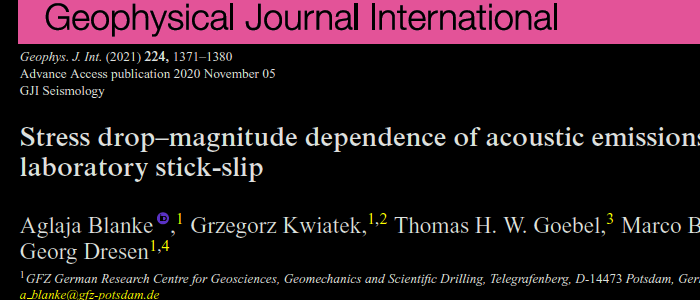Aglaja Blanke from our section published paper in Gephysical Journal International entitled “Stress drop–magnitude dependence of acoustic emissions during laboratory stick-slip”. In this study she used spectral ratio technique to derive static stress drops of very small earthquakes of sub-milimited size recorded during two stick-slip experiments performed on Westerly Granite samples. She found that in contrast to most case studies for natural earthquakes, a strong increase in seismic stress drop with acoustic emission event size (i.e. magnitude) was observed, and that this apparent breakdown in scaling is governed by fault roughness.
Abstract
Earthquake source parameters such as seismic stress drop and corner frequency are observed to vary widely, leading to persistent discussion on potential scaling of stress drop and event size. Physical mechanisms that govern stress drop variations are difficult to evaluate in nature and are more readily studied in controlled laboratory experiments. We perform two stick-slip experiments on fractured (rough) and cut (smooth) Westerly granite samples to explore fault roughness effects on acoustic emission (AE) source parameters. We separate large stick-slip events that generally saturate the seismic recording system from populations of smaller AE events which are sensitive to fault stresses prior to slip. AE event populations show many similarities to natural seismicity and may be interpreted as laboratory equivalent of natural micro-seismic events. We then compare the temporal evolution of mechanical data such as measured stress release during slip to temporal changes in stress drops derived from AEs using the spectral ratio technique. We report on two primary observations: 1) In contrast to most case studies for natural earthquakes, we observe a strong increase in seismic stress drop with AE size. 2) The scaling of stress drop with magnitude is governed by fault roughness, whereby the rough fault shows a more rapid increase of the stress drop – magnitude relation with progressing large stick-slip events than the smooth fault. The overall range of AE sizes on the rough surface is influenced by both the average grain size and the width of the fault core. The magnitudes of the smallest AE events on smooth faults may also be governed by grain size. However, AEs significantly grow beyond peak-roughness and the width of the fault core. Our laboratory tests highlight that source parameters vary substantially in the presence of fault zone heterogeneity (i.e. roughness and narrow grain size distribution), which may affect seismic energy partitioning and static stress drops of small and large AE events.
Reference
Blanke, A., G. Kwiatek, T. H. W. Goebel, M. Bohnhoff, and G. Dresen (2020). Stress drop–magnitude dependence of acoustic emissions during laboratory stick-slip. Geophysical Journal International 224, 1371–1380, DOI: 10.1093/gji/ggaa524. [ Article Page ] [ Link to associated data publication ]
